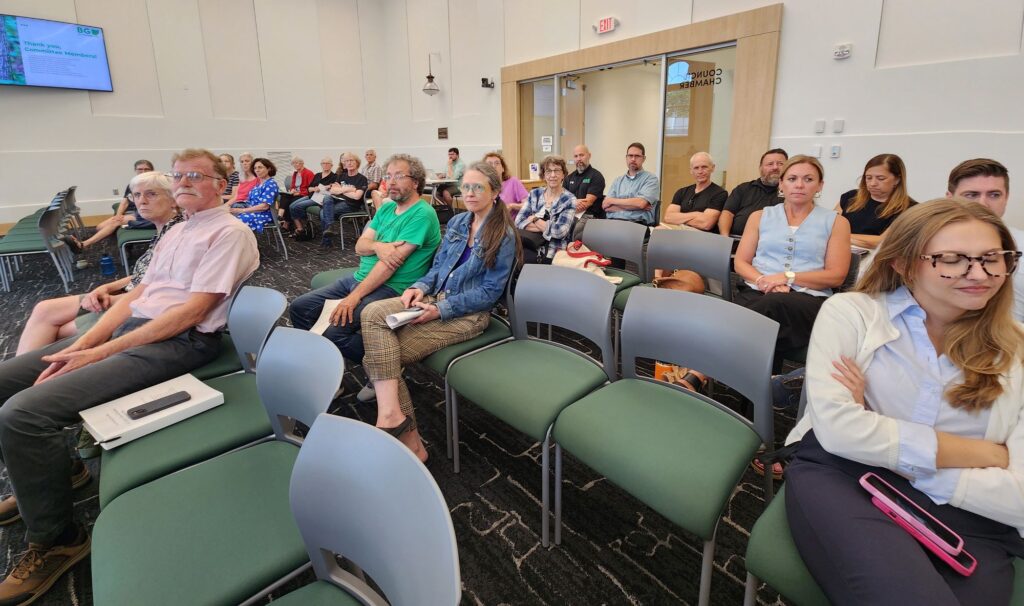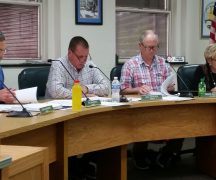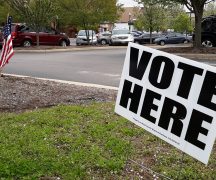By JAN McLAUGHLIN
BG Independent News
In the interest of the environment, city officials did not print off paper copies of the nearly 300-page Bowling Green Climate Action and Resiliency Improvement Plan.
Instead the city’s Communication Director Amanda Gamby gave the highlights of the plan that has been two years in the making. The report was presented to City Council’s Committee of the Whole on Monday evening.
“When we initially set out to tackle this, we thought we were going to have it done in a year,” Gamby said.
But the effort proved more complex than originally thought when City Council passed a resolution asking the city administration to come up with a plan.
“Much hard work and due diligence went into this,” Mayor Mike Aspacher said. The result “exceeded my expectations.”
“The final plan truly is an impressive document,” he said, that identifies specific steps the city needs to take to reduce its impact on the environment and to become more resilient to the changing climate.
Gamby acknowledged that climate change is still a “very politicized topic.” However, she cited climate changes being recorded here and elsewhere. “You can’t just ignore them and pretend they aren’t happening.”
Working on the plan were people with expertise in sustainability, science, economic development, utilities, and industry. Gamby stressed the value of having diversity on the committee, since the decisions made would impact local residents and businesses.
“It was important for us to have those folks in the room,” she said.
Historically the city has adopted several practices that support and encourage resiliency and sustainable use of resources to reduce human impact on the environment.
The 2024 Climate Action and Resiliency Improvement Plan recommends steps necessary to improve community resiliency and achieve net zero greenhouse gas emissions from electricity production and city operations, within specified guidelines – subject to approval by the Mayor, City Council, and Board of Public Utilities.
The city already has an inventory of the sustainability initiatives taking place in the city, and has completed an inventory of government operations’ greenhouse gas emissions.
Through the planning process, the city will try to reach net zero greenhouse gas emissions from electricity production and government operations. The 2024 plan identifies existing barriers and recommends actions necessary to meet this goal, including actionable steps, possible funding sources, and accountability measures. It also includes strategies to encourage citizens to act to address their individual greenhouse gas emissions, and recommendations for educating the community about the plan’s goals and progress.
A climate vulnerability assessment was also produced.
“We’re already seeing the effects of climate change,” Gamby said, with more heavy rainfalls in shorter periods, and more days with temperatures above 90 degrees.
Community resiliency is a concept that extends beyond greenhouse gas emissions and requires both an evaluation of climate vulnerabilities and a description of potential mitigation efforts designed to protect lives and property.
It is the intention of this report to move sustainability and resiliency efforts for BG forward in a timely manner, and in doing so to address the most significant aspect of climate change for local communities and for local governments—the threats of climate-caused, environmental hazards to the health and safety of persons, security of property, and survival of critical infrastructure.
A stormwater management plan is also part of the overall plan, to prevent street flooding and water quality degradation during rainstorm events.
One effect of climate change has been the increasing intensity of rainstorms due both to enhanced pressure gradients leading to more thunderstorms, and the increased water-holding capacity of warmer air. Recent studies have shown that projected rainfall-runoff changes due to climate change by 2050 will result in a high percentage of the nation’s stormwater systems being under-designed and potentially failing.
The Climate Action and Resiliency Improvement Plan can be found on the city’s website – https://www.bgohio.org/687/2024-Climate-Action-and-Resiliency-Impro.

The principal findings of the CAP committee are as follows:
Climate risks
There are significant risks of climate-related, environmental hazards to this community due to the intensification of natural processes such as floods, droughts, tornadoes, winter storms, and heat waves.
Carbon emissions
The carbon emissions from the Bowling Green community are far larger than the carbon emissions from government operations alone. The carbon emissions from electricity generation for government operations are 5,952 metric tons of CO2 equivalent versus carbon emissions of 369,764 MTCO2e for the entire community; in other words, carbon emissions for electricity generation for government operations is 1.6% of the community total. Including natural gas, gasoline, and diesel fuel use, government operations are probably responsible for about 3% of the total carbon emissions of the community at large.
There are two important conclusions to draw from this. First, the critical action is finding ways for the entire community to reduce carbon emissions, not just to address government operations. Second, although the government operations section is relatively small in the total emissions picture, government plays an outsized role because as a municipal power provider, it decides the nature of the energy portfolio for the entire community.
Net zero – not yet
At this time, it will not be possible to achieve net zero carbon emissions solely through changes in energy sources (e.g., replacing fossil fuel power supplies with renewable energy sources). There are two reasons for this. First, the dependability of the electric system requires adequate base load energy sources, whereas renewable energy sources such as wind and solar are not always available and require battery storage to augment their reliability.
Second, there will always be times of increased electricity demand (peak electricity) or times of emergency power demand (due to disruption or damage to the regional power grid from storms, fires, or other disasters). At this time, peak and emergency power demands can only be met using stand-by natural gas or diesel generators, because these energy sources can be activated quickly.
Accordingly, at the present time, net zero carbon emissions can only be achieved by a combination (or joint strategy) involving shifts of the energy portfolio to renewable energy sources, reductions in energy use, and significant carbon offsets (e.g., use of RECs, increases in green space, canopy tree cover, native habitat restoration, etc.).
Energy portfolio
Shifts in the energy portfolio include five components. First, the city receives a large portion of its power supply from Prairie State which the city has a long-term contract with AMP. Prairie State is the largest carbon emitting resource in the city’s portfolio. While Prairie State has operated extremely reliably, there is environmental pressure to reduce carbon emissions from Prairie State such as the State of Illinois Climate and Equitable Jobs Act, which requires Prairie State to achieve 45% reduction in carbon emissions by 2035 and 100% reduction of carbon emissions by 2045. Also, in 2024 the US EPA proposed regulations that all coal-fired power plants expected to operate until 2039 or beyond must reduce carbon emissions 90% by 2032, although several states will likely challenge the EPA regulations.
While reducing the dependence on fossil fuel generation is a critical step towards reaching net zero carbon emissions, the city has a long term take or pay contract with AMP for the PS project. In 2007, the city contracted with AMP to purchase 35 MW of output from the facility.
The city should consider purchasing RECs to offset the carbon emissions related to the portion of the city’s energy portfolio (~50%) provided by Prairie State. Second, it is desirable to replace Bowling Green’s JV6 wind farm, planned for decommissioning in 2025, with a suitable renewable energy replacement. Third, the Water Treatment Plant and Wastewater Treatment Plant currently purchase most of their energy from the electric market with about 15% to 20% from a short-term wind energy contract. The electric market includes all energy resource types including fossil fuel and renewables and the city should work toward increasing the amount of renewable energy purchased to power the plants or purchase RECs to offset carbon emissions. Fourth, the city should consider potential vulnerabilities of the hydroelectric resources on the Ohio River due to the potential of climate change that may affect their operation. Fifth, the city is encouraged to track developing technology in energy storage systems which may make renewable energy sources such as wind or solar more dependable components of BG’s energy portfolio.
Reduce energy use and emissions
Reductions in energy use/emission reductions include three components. First, multiple public buildings need significant upgrades and replacements, including improved HVAC systems, replacing furnaces with heat pumps, replacing diesel-powered back-up generators with natural gas generators or battery systems, replacing lighting with LED lights, replacing existing windows and doors with energy-efficient upgrades, replacing black roofs with white/reflective roofs, and other improvements.
Second, a significant portion of city energy use is by water and wastewater treatment services. Continued improvements and maintenance in the efficiency of pumps (almost all pumps have Variable Frequency Drives (VFDs) and blowers ($4.6MM recently invested on blower upgrades at the Wastewater Treatment Plant), and energy efficiency of related buildings and facilities could play a role in reaching net zero carbon emissions.
Third, there are emissions reductions to be achieved in the transportation sector. The city transportation fleet is in the process of conversion or replacement by hybrid or electric vehicles. The process has started with commercially available cars or SUVs. Larger vehicles can be considered in the future when commercially available and electric charging infrastructure is more prevalent. Problems remain with both the availability and the cost feasibility of purchasing electric heavy trucks and increasing the availability of fast electrical charging stations.
Additionally, these vehicles are often needed during emergency operations for long durations or require the ability to drive long distances for mutual aid response. The city can provide commuters with alternatives to use of gasoline-powered vehicles by prioritizing ways to increase pedestrian safety and ways to promote bicycling.
Carbon offsets
BG’s renewable energy resources contribute to the regional power grid and earn renewable energy certificates (RECs) equivalent to about $1.5 million per year. At the present, BG sells these RECs and uses the revenue to offset power supply costs for the benefit of consumers. The city could retire its RECs to offset our own carbon emissions, as a pathway to achieve net zero carbon emissions.
The city could use the $1.5 million to purchase lower value, unbundled RECs to compensate for BG’s carbon emissions. BG could attain its net zero carbon emissions mandate by completely compensating for the carbon emissions from fossil fuel resources. Retiring (instead of selling) RECs would result in revenue loss to BG of $1.5 million per year, which might result in an approximately 3% increase in electric utility rates.
Second, there are continuing efforts to reduce, repurpose, and recycle materials. Problems remain with funding sources and the larger market in recycled materials. Third, there are continuing efforts to increase green space, natural area restoration, rain gardens, and canopy tree cover. The replacement of non-native vegetation with native vegetation offsets carbon emissions, provides canopy shade to reduce the impact of heat waves, and reduces water and energy expenditures during maintenance activities.
Public education
There is continued need for public outreach, education, and participation in Bowling Green’s efforts to achieve net zero carbon emissions. City operations (the focus of this report) remain only a small portion of the total GHG emissions inventory for this community. The city might prioritize incentives to stimulate and support citizen-led efforts to address resiliency and sustainability.
Funding
The city might consider “embedding” climate-change funding into annual operating budgets. Embedding is a budgetary concept involving a long-term commitment to proactively anticipate problems rather than respond to them after the fact. Examples of embedding include purchasing and stockpiling necessary equipment and non-perishable supplies, conducting personnel training, implementing pilot mitigation programs, obtaining expert consultation and advice, purchasing environmental insurance policies to help rebuild from natural disasters, and appropriating matching or in-kind funds for federal or state funding.
More studies
Regarding planning for the future and prospective change, BG might benefit from a number of additional studies. First, it might be valuable to hire an energy consultant tasked with preparing an integrated resource plan to identify the long-term energy resource strategy after current long term generation assets are retired. Second, a master plan for building replacement, renovation, or other upgrades to prioritize deferred maintenance issues might be useful. Third, a master plan for green space expansion, reforestation, and natural area improvements might also be useful. Fourth, an evaluation by an environmental engineering company of BG’s stormwater management system might prevent possible future flood damages due to high rain events.
Set targets
The committee recommends setting 2025-2035 for short-term actions; 2035-2045 for intermediate-term actions; and 2045-2055 for long-term actions.





